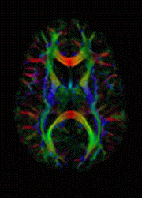
Photo from wikipedia
Simple Summary This work aims to evaluate the utility of fusing T2-weighted images with diffusion-weighted images to determinate the depth of myometrial invasion and the stage of endometrial cancer. By… Click to show full abstract
Simple Summary This work aims to evaluate the utility of fusing T2-weighted images with diffusion-weighted images to determinate the depth of myometrial invasion and the stage of endometrial cancer. By showing its superior diagnostic performance, we aim to encourage its use in endometrial cancer staging, and, in the future, obviate the need for intravenous contrast medium administration. Abstract Endometrial cancer is the eighth most common cancer worldwide, and its prognosis depends on various factors, with myometrial invasion having a major impact on prognosis. Optimizing MRI protocols is essential, and it would be useful to improve the diagnostic accuracy without the need for other sequences. We conducted a retrospective, single-center study, which included a total of 87 patients with surgically confirmed primary endometrial cancer, and who had undergone a pre-operative pelvic MRI. All exams were read by an experienced radiologist dedicated to urogenital radiology, and the depth of myometrial invasion was evaluated using T2-Weighted Images (T2WI) and fused T2WI with Diffusion-Weighted Images (DWI). Both results were compared to histopathological evaluations. When comparing both sets of imaging (T2WI and fused T2WI-DWI images) in diagnosing myometrial invasion, the fused images had better accuracy, and this difference was statistically significant (p < 0.001). T2WI analysis correctly diagnosed 82.1% (70.6–88.7) of cases, compared to 92.1% correctly diagnosed cases with fused images (79.5–97.2). The addition of fused images to a standard MRI protocol improves the diagnostic accuracy of myometrial invasion depth, encouraging its use, since it does not require more acquisition time.
Journal Title: Cancers
Year Published: 2022
Link to full text (if available)
Share on Social Media: Sign Up to like & get
recommendations!